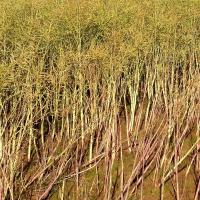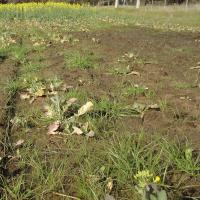Diagnosing waterlogging in canola
Canola is more susceptible to waterlogging than cereals after the seed has imbibed (absorbed water before germination).
If waterlogging occurs immediately after sowing then canola seed has been shown to be more waterlogging tolerant than other common crop types.
What to look for
- Poor germination or purple-yellow plants, in water collecting areas, particularly on shallow duplex soils.
- Bare wet soil and/or water-loving weeds present.
- Plant lodging and early death in waterlogging prone areas.
- Saline areas are more affected.
Paddock
- Waterlogged seedlings can die before emergence or show symptoms similar to nitrogen deficiency.
- Stunted plants and lower leaves turn purple-red to yellow, then die.
- Prolonged waterlogging causes root death and eventually death of the whole plant. Plants are more susceptible to root disease.
- Waterlogging of adult plants causes yellowing of lower leaves.
- Salinity magnifies waterlogging effects, with more marked stunting and oldest leaf marginal necrosis and death.
Plant
What else could it be
| Condition | Similarities | Differences |
|---|---|---|
| Diagnosing salinity in canola | Most saline areas also intermittently waterlogged; poor emergence, pale seedlings. | Salinity has a greater effect on germination and yield, in addition the oldest leaves have scorched edges. |
| Diagnosing nitrogen deficiency in canola | Upright purple and red to yellow older leaves | Plants not restricted to winter- wet areas and have pruned or dying roots. |
| Diagnosing damping off in canola | Poor emergence, dying or stunted seedlings, orange-red oldest leaves that die back from edges. Damping off is more common in wet areas. | Plants have a pinched hypocotl or root and not restricted to waterlogged areas. |
Where does it occur?

Soil type

Wet conditions
- Areas affected by secondary salinity. Germination and early growth can be much worse on saline areas after waterlogging events
- Water accumulating or poorly drained areas such as valleys, at the change of slope or below rocks Duplex soils, particularly sandy duplexes with less than 30 cm sand over clay
- Low nitrogen status crops
- In very warm conditions when oxygen is more rapidly depleted in the soil and growth rates are greater
- Deeper sown crops
Management strategies
- Sow as early as possible with a higher seeding rate.
- Engineering solutions such as drainage may be possible for waterlogging and secondary salinity but must be assessed on a site by site basis.
- Raised beds are more effective on relatively flat areas and on heavier textured soils in waterlogged areas, but areas need to be large enough to justify machinery costs.
How can it be monitored?

Soil test
- Plants can be waterlogged when there is a watertable within 30 cm of the surface and no indication of waterlogging at the surface. Water levels can be monitored with bores or observation pits, but watertables can vary greatly over short distances. Depending on soil type waterlogging can appear to drain quickly but the soil conditions can remain waterlogged for several days until fully aerated.
- The salinity status of a soil can be assessed from indicator plants, measuring the salt concentration in soil samples or with electromagnetic-induction instruments, or by measuring the depth to a saline watertable.
- Observe plant symptoms and paddock clues and verify by digging a hole.
See also
Further information
Page last updated: Friday, 29 July 2022 - 3:41pm



